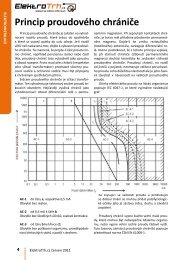Develop a time stamping application in PlantStruxure? - Schneider ...
Develop a time stamping application in PlantStruxure? - Schneider ...
Develop a time stamping application in PlantStruxure? - Schneider ...
You also want an ePaper? Increase the reach of your titles
YUMPU automatically turns print PDFs into web optimized ePapers that Google loves.
1-Introduction<br />
1. Introduction<br />
1.1. Purpose<br />
With cont<strong>in</strong>uous developments <strong>in</strong> <strong>in</strong>dustry and technology, more and more<br />
automation systems are be<strong>in</strong>g implemented <strong>in</strong> different fields. For better control and<br />
ma<strong>in</strong>tenance of complex systems, end users of these automation systems require<br />
process<strong>in</strong>g data with <strong>time</strong> stamps.<br />
This guide proposes a method to implement a <strong>time</strong> <strong>stamp<strong>in</strong>g</strong> solution us<strong>in</strong>g a<br />
Programmable Automation Controller (PAC) and a SCADA system. Moreover, this<br />
STG suggests the best practices to follow to take advantage of system openness<br />
while reduc<strong>in</strong>g the risks of misuse and misunderstand<strong>in</strong>gs.<br />
The recommendations and guidel<strong>in</strong>es provided <strong>in</strong> the follow<strong>in</strong>g chapters are generic<br />
and targeted at <strong>time</strong> <strong>stamp<strong>in</strong>g</strong> <strong>application</strong>s such as track<strong>in</strong>g a sequence of events<br />
(SOE) or <strong>time</strong> <strong>stamp<strong>in</strong>g</strong> alarms. However, we use the specific example of a sequence<br />
of events (SOE) function <strong>in</strong> a hydro power plant to illustrate a <strong>time</strong> <strong>stamp<strong>in</strong>g</strong><br />
<strong>application</strong> <strong>in</strong> a process control system.<br />
1.2. Introduction to <strong>time</strong> <strong>stamp<strong>in</strong>g</strong><br />
1.2.1 What is <strong>time</strong> <strong>stamp<strong>in</strong>g</strong><br />
A <strong>time</strong> stamp <strong>in</strong> an automation system is the <strong>time</strong> <strong>in</strong>formation of when a signal event<br />
occurred. It is recorded by the control units <strong>in</strong> a consistent format. The function of<br />
record<strong>in</strong>g the <strong>time</strong> stamps is called <strong>time</strong> <strong>stamp<strong>in</strong>g</strong>.<br />
Time <strong>stamp<strong>in</strong>g</strong> is an important function for track<strong>in</strong>g processes <strong>in</strong> some automation<br />
systems, such as hydro power plant control and oil pipel<strong>in</strong>e control. This function<br />
provides operators with a method to better identify process sequences <strong>in</strong> a large and<br />
complex system, to f<strong>in</strong>e tune protection and control schemes, and improve overall<br />
system reliability. One of the most important <strong>application</strong>s of <strong>time</strong> <strong>stamp<strong>in</strong>g</strong> is to help<br />
track down the root causes after a system error is detected.<br />
1.2.2 What is the process flow of the <strong>time</strong> <strong>stamp<strong>in</strong>g</strong> function<br />
The <strong>time</strong> <strong>stamp<strong>in</strong>g</strong> function <strong>in</strong> a process automation system can be implemented <strong>in</strong><br />
three steps: <strong>time</strong> sourc<strong>in</strong>g, <strong>stamp<strong>in</strong>g</strong> <strong>time</strong> on the event data, and monitor<strong>in</strong>g & <strong>in</strong>quiry.<br />
The follow<strong>in</strong>g flow chart shows the <strong>time</strong> <strong>stamp<strong>in</strong>g</strong> process:<br />
9

















